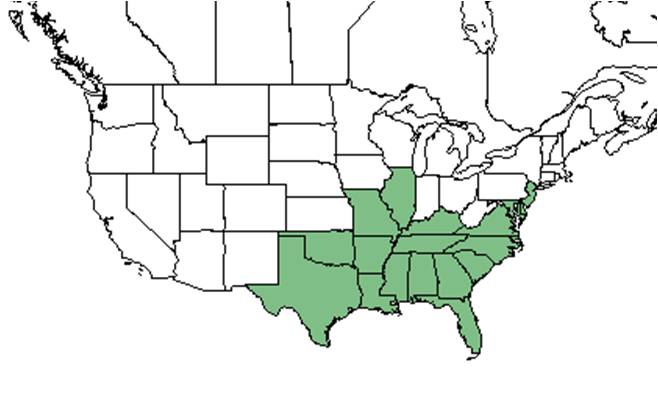Difference between revisions of "Quercus nigra"
Juliec4335 (talk | contribs) |
Juliec4335 (talk | contribs) |
||
| Line 31: | Line 31: | ||
''Q. nigra'' responds positively to soil disturbance by heavy silvilculture in North Carolina.<ref>Cohen, S., R. Braham, and F. Sanchez. (2004). Seed Bank Viability in Disturbed Longleaf Pine Sites. Restoration Ecology 12(4):503-515.</ref> However, it responds negatively to soil disturbance by clearcutting and chopping in North Florida flatwoods forests.<ref>Moore, W.H., B.F. Swindel, and W.S. Terry. (1982). Vegetative Response to Clearcutting and Chopping in a North Florida Flatwoods Forest. Journal of Range Management 35(2):214-218.</ref> | ''Q. nigra'' responds positively to soil disturbance by heavy silvilculture in North Carolina.<ref>Cohen, S., R. Braham, and F. Sanchez. (2004). Seed Bank Viability in Disturbed Longleaf Pine Sites. Restoration Ecology 12(4):503-515.</ref> However, it responds negatively to soil disturbance by clearcutting and chopping in North Florida flatwoods forests.<ref>Moore, W.H., B.F. Swindel, and W.S. Terry. (1982). Vegetative Response to Clearcutting and Chopping in a North Florida Flatwoods Forest. Journal of Range Management 35(2):214-218.</ref> | ||
| − | ''Quercus nigra'' is frequent and abundant in the North Florida Longleaf Woodlands community | + | ''Quercus nigra'' is frequent and abundant in the North Florida Longleaf Woodlands and Xeric Flatwoods community types as described in Carr et al. (2010).<ref>Carr, S.C., K.M. Robertson, and R.K. Peet. 2010. A vegetation classification of fire-dependent pinelands of Florida. Castanea 75:153-189.</ref> |
===Phenology=== <!--Timing off flowering, fruiting, seed dispersal, and environmental triggers. Cite PanFlora website if appropriate: http://www.gilnelson.com/PanFlora/ --> | ===Phenology=== <!--Timing off flowering, fruiting, seed dispersal, and environmental triggers. Cite PanFlora website if appropriate: http://www.gilnelson.com/PanFlora/ --> | ||
Revision as of 11:35, 23 July 2020
| Quercus nigra | |
|---|---|

| |
| Photo by Wayne Matchett, SpaceCoastWildflowers.com | |
| Scientific classification | |
| Kingdom: | Plantae |
| Division: | Magnoliophyta - Flowering plants |
| Class: | Magnoliopsida – Dicotyledons |
| Order: | Fagales |
| Family: | Fagaceae |
| Genus: | Quercus |
| Species: | Q. nigra |
| Binomial name | |
| Quercus nigra L. | |

| |
| Natural range of Quercus nigra from USDA NRCS Plants Database. | |
Common name: Water oak
Contents
Taxonomic notes
Synonyms: Quercus nigra var. heterophylla (Aiton) W.W. Ashe; Q. aquatica Walter
Description
A description of Quercus nigra is provided in The Flora of North America.
Distribution
Ecology
Habitat
Q. nigra responds positively to soil disturbance by heavy silvilculture in North Carolina.[1] However, it responds negatively to soil disturbance by clearcutting and chopping in North Florida flatwoods forests.[2]
Quercus nigra is frequent and abundant in the North Florida Longleaf Woodlands and Xeric Flatwoods community types as described in Carr et al. (2010).[3]
Phenology
Q. nigra has been observed flowering in February and March.[4]
Seed dispersal
This species is thought to be dispersed by gravity. [5]
Pollination
The following Hymenoptera families and species were observed visiting flowers of Quercus nigra at Archbold Biological Station: [6]
Apidae: Apis mellifera
Conservation and management
Cultivation and restoration
Photo Gallery
References and notes
- ↑ Cohen, S., R. Braham, and F. Sanchez. (2004). Seed Bank Viability in Disturbed Longleaf Pine Sites. Restoration Ecology 12(4):503-515.
- ↑ Moore, W.H., B.F. Swindel, and W.S. Terry. (1982). Vegetative Response to Clearcutting and Chopping in a North Florida Flatwoods Forest. Journal of Range Management 35(2):214-218.
- ↑ Carr, S.C., K.M. Robertson, and R.K. Peet. 2010. A vegetation classification of fire-dependent pinelands of Florida. Castanea 75:153-189.
- ↑ Nelson, G. PanFlora: Plant data for the eastern United States with emphasis on the Southeastern Coastal Plains, Florida, and the Florida Panhandle. www.gilnelson.com/PanFlora/ Accessed: 13 DEC 2016
- ↑ Kirkman, L. Katherine. Unpublished database of seed dispersal mode of plants found in Coastal Plain longleaf pine-grasslands of the Jones Ecological Research Center, Georgia.
- ↑ Deyrup, M.A. and N.D. 2015. Database of observations of Hymenoptera visitations to flowers of plants on Archbold Biological Station, Florida, USA.